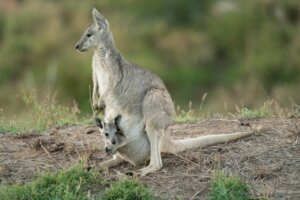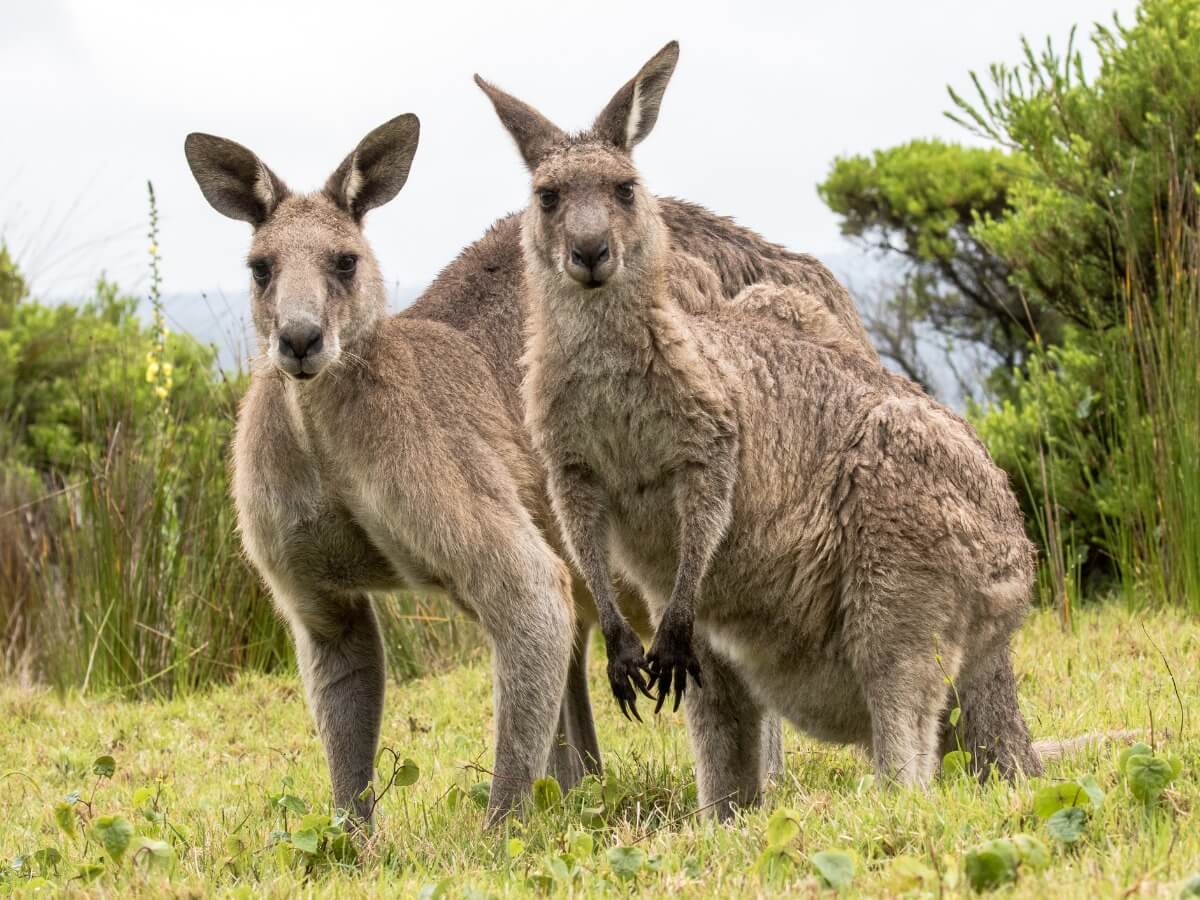Eastern Grey Kangaroo: Habitat and Characteristics

Australia’s native fauna includes the eastern grey kangaroo. This marsupial is related to other mammals such as wallabies and other species that make up the Macropodidae family. It’s a fascinating animal, so it’s worth learning some facts about it.
A little-known detail about the word “kangaroo” is that we use it to talk about any of the species in this group. However, it’s usually used to refer to the larger specimens within the group of these herbivores. Want to know more about these animals? What traits differentiate the eastern grey kangaroo from its relatives? Read on!
Habitat of the eastern grey kangaroo
As the name suggests, the eastern grey kangaroo resides on the southern and eastern coasts of Australia (as well as Tasmania). Within these regions, these marsupials can be found in a wide variety of habitats, from forests to grasslands.
All ecosystems inhabited by kangaroos are characterized by main zones: one where it rains frequently and another that’s classified as semi-arid.

Physical characteristics
Before we get into the physical characteristics of this eastern species, we need to mention that there are also western grey kangaroos. Although the latter were considered to be a subspecies of the specimens we are concerned with here, they’ve been defined as two distinct species.
For this reason, the eastern species is identified as Macropus giganteus and the western species as Macropus fuliginosus. In turn, the eastern grey kangaroo encompasses two subspecies differentiated according to the distribution of each one:
- Australian: This subspecies is called M. giganteus giganteus.
- Tasmanian: The subspecies is recognized as M. giganteus tasmaniensis.
Both subspecies show different color patterns varying from gray to brown on the upper body and white on the front lower sections. Fortunately, being bipedal animals, their identification at a glance is easier.
Moreover, in this species, a clear sexual dimorphism between males and females can be observed. Specifically, males can be double or triple the weight of a female, while in size they’re over a meter in height (3.3 feet), but never exceed two meters (6.6 feet). Females, on the other hand, reach a maximum height of just one meter.
As for the length of the tail, it’s measured separately from the rest of the body and it also differs according to sex. In the case of males, it can measure 109 centimeters (3.6 feet), but in females, it remains at a solid 84 centimeters (2.75 feet).
However, the most striking feature of this species is the marsupium. This pouch is present only in females and allows the young to complete their development. In addition, it also acts as protection, as it allows them to hide from predators.
The behavior of the species
Kangaroos are social mammals that usually live in small groups consisting of a dominant male, 2-3 females, their young, and 2-3 young males. It has been observed that they avoid the hottest hours of the day and that they communicate by emitting a series of characteristic sounds, called clucks.
Feeding of the eastern grey kangaroo
Like the rest of the species of the family Macropodidae, the populations of the eastern grey kangaroo are characterized by being exclusively herbivorous. Therefore, these marsupials feed on different types of plant sources such as leaves, shrubs, tree bark, and various plant species. They avoid eating dry grass, as this makes it difficult to digest.
Reproduction of the eastern grey kangaroo
The arrival of spring and the beginning of summer is the starting signal for the reproductive period of the eastern grey kangaroo. In contrast, all other kangaroo species breed throughout the year provided conditions are optimal.
During these months, the behavior of the members of this species is associated with repetitive behaviors. For example, the male kangaroo fights against another male specimen by boxing or other aggressive behaviors. He seeks to display his superiority with these acts.
Of all the males, the dominant male is the one with the greatest number of opportunities to mate with a female in heat. When it comes to courtship, many kangaroo species behave in the same way: the male makes clucking noises and shakes his tail and head in order to establish his dominant position in the hierarchy.
A curious evolutionary strategy of kangaroos is the so-called embryonic diapause, in which the development of the zygote stops and enters a state of lethargy. In this way, the female ensures that the zygote will mature when conditions are right.
Conservation status
Last but not least, it should be noted that populations of the eastern grey kangaroo remain stable. Due to this situation, the conservation status of this marsupial is classified as “Least Concern (LC)” by the International Union for Conservation of Nature (IUCN).
It’s believed that there are about 2,000,000 specimens alive in the wild today.
In summary, the eastern grey kangaroo is a species endemic to the Australian continent. It differs in specific details from its western congener, but we need to make clear that both kangaroos (and all animals in general) are essential to the well-being of the environment they reside in.
Australia’s native fauna includes the eastern grey kangaroo. This marsupial is related to other mammals such as wallabies and other species that make up the Macropodidae family. It’s a fascinating animal, so it’s worth learning some facts about it.
A little-known detail about the word “kangaroo” is that we use it to talk about any of the species in this group. However, it’s usually used to refer to the larger specimens within the group of these herbivores. Want to know more about these animals? What traits differentiate the eastern grey kangaroo from its relatives? Read on!
Habitat of the eastern grey kangaroo
As the name suggests, the eastern grey kangaroo resides on the southern and eastern coasts of Australia (as well as Tasmania). Within these regions, these marsupials can be found in a wide variety of habitats, from forests to grasslands.
All ecosystems inhabited by kangaroos are characterized by main zones: one where it rains frequently and another that’s classified as semi-arid.

Physical characteristics
Before we get into the physical characteristics of this eastern species, we need to mention that there are also western grey kangaroos. Although the latter were considered to be a subspecies of the specimens we are concerned with here, they’ve been defined as two distinct species.
For this reason, the eastern species is identified as Macropus giganteus and the western species as Macropus fuliginosus. In turn, the eastern grey kangaroo encompasses two subspecies differentiated according to the distribution of each one:
- Australian: This subspecies is called M. giganteus giganteus.
- Tasmanian: The subspecies is recognized as M. giganteus tasmaniensis.
Both subspecies show different color patterns varying from gray to brown on the upper body and white on the front lower sections. Fortunately, being bipedal animals, their identification at a glance is easier.
Moreover, in this species, a clear sexual dimorphism between males and females can be observed. Specifically, males can be double or triple the weight of a female, while in size they’re over a meter in height (3.3 feet), but never exceed two meters (6.6 feet). Females, on the other hand, reach a maximum height of just one meter.
As for the length of the tail, it’s measured separately from the rest of the body and it also differs according to sex. In the case of males, it can measure 109 centimeters (3.6 feet), but in females, it remains at a solid 84 centimeters (2.75 feet).
However, the most striking feature of this species is the marsupium. This pouch is present only in females and allows the young to complete their development. In addition, it also acts as protection, as it allows them to hide from predators.
The behavior of the species
Kangaroos are social mammals that usually live in small groups consisting of a dominant male, 2-3 females, their young, and 2-3 young males. It has been observed that they avoid the hottest hours of the day and that they communicate by emitting a series of characteristic sounds, called clucks.
Feeding of the eastern grey kangaroo
Like the rest of the species of the family Macropodidae, the populations of the eastern grey kangaroo are characterized by being exclusively herbivorous. Therefore, these marsupials feed on different types of plant sources such as leaves, shrubs, tree bark, and various plant species. They avoid eating dry grass, as this makes it difficult to digest.
Reproduction of the eastern grey kangaroo
The arrival of spring and the beginning of summer is the starting signal for the reproductive period of the eastern grey kangaroo. In contrast, all other kangaroo species breed throughout the year provided conditions are optimal.
During these months, the behavior of the members of this species is associated with repetitive behaviors. For example, the male kangaroo fights against another male specimen by boxing or other aggressive behaviors. He seeks to display his superiority with these acts.
Of all the males, the dominant male is the one with the greatest number of opportunities to mate with a female in heat. When it comes to courtship, many kangaroo species behave in the same way: the male makes clucking noises and shakes his tail and head in order to establish his dominant position in the hierarchy.
A curious evolutionary strategy of kangaroos is the so-called embryonic diapause, in which the development of the zygote stops and enters a state of lethargy. In this way, the female ensures that the zygote will mature when conditions are right.
Conservation status
Last but not least, it should be noted that populations of the eastern grey kangaroo remain stable. Due to this situation, the conservation status of this marsupial is classified as “Least Concern (LC)” by the International Union for Conservation of Nature (IUCN).
It’s believed that there are about 2,000,000 specimens alive in the wild today.
In summary, the eastern grey kangaroo is a species endemic to the Australian continent. It differs in specific details from its western congener, but we need to make clear that both kangaroos (and all animals in general) are essential to the well-being of the environment they reside in.
All cited sources were thoroughly reviewed by our team to ensure their quality, reliability, currency, and validity. The bibliography of this article was considered reliable and of academic or scientific accuracy.
- Macropus giganteus (eastern gray kangaroo). (2021). Animal Diversity Web. https://animaldiversity.org/accounts/Macropus_giganteus/
- The Australian Museum. (2020, 9 diciembre). Eastern Grey Kangaroo. https://australian.museum/learn/animals/mammals/eastern-grey-kangaroo/
- Munny, P. (2015, 15 junio). The IUCN Red List of Threatened Species. IUCN Red List of Threatened Species. https://www.iucnredlist.org/species/41513/21952954
This text is provided for informational purposes only and does not replace consultation with a professional. If in doubt, consult your specialist.








